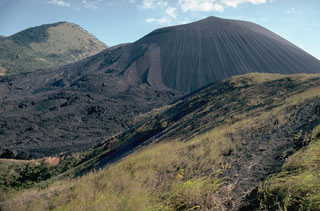Report on Cerro Negro (Nicaragua) — March 1993
Bulletin of the Global Volcanism Network, vol. 18, no. 3 (March 1993)
Managing Editor: Edward Venzke.
Cerro Negro (Nicaragua) No fumarolic activity; vegetation recovers from 1992 eruption
Please cite this report as:
Global Volcanism Program, 1993. Report on Cerro Negro (Nicaragua) (Venzke, E., ed.). Bulletin of the Global Volcanism Network, 18:3. Smithsonian Institution. https://doi.org/10.5479/si.GVP.BGVN199303-344070
Cerro Negro
Nicaragua
12.506°N, 86.702°W; summit elev. 728 m
All times are local (unless otherwise noted)
"No sign of fumarolic activity was seen when the base of Cerro Negro was visited on 6 January. Predictions that the farming area between Cerro Negro and the city of León (18 km WSW), would be devastated by the ashfall of April 1992 (about 4 cm of ashfall) had fortunately not been fulfilled. Fields >2 km from the volcano were cultivated again after the April 1992 event and farmers were expecting good harvests. Wild vegetation appeared healthy and had regrown to original levels. A few large trees close to the volcano appeared to have died after the eruption."
Geological Summary. Nicaragua's youngest volcano, Cerro Negro, was created following an eruption that began in April 1850 about 2 km NW of the summit of Las Pilas volcano. It is the largest, southernmost, and most recent of a group of four youthful cinder cones constructed along a NNW-SSE-trending line in the central Marrabios Range. Strombolian-to-subplinian eruptions at intervals of a few years to several decades have constructed a roughly 250-m-high basaltic cone and an associated lava field constrained by topography to extend primarily NE and SW. Cone and crater morphology have varied significantly during its short eruptive history. Although it lies in a relatively unpopulated area, occasional heavy ashfalls have damaged crops and buildings.
Information Contacts: Andrea Borgia, Instituto Nazionale di Geofisica, via di Vigna Murata 605, 00143 Roma, Italy; B. van Wyk de Vries, Open Univ; Peter J. Baxter, Dept of Community Medicine, Fenner's, Gresham Road, Cambridge, England.

